Discover 35 hidden attractions, cool sights, and unusual things to do in Rio de Janeiro (Brazil). Don't miss out on these must-see attractions: Christ the Redeemer Statue, Sugarloaf Mountain, and MAM. Also, be sure to include Eva Klabin House Museum in your itinerary.
Below, you can find the list of the most amazing places you should visit in Rio de Janeiro (Rio de Janeiro).
Table of Contents
Christ the Redeemer Statue
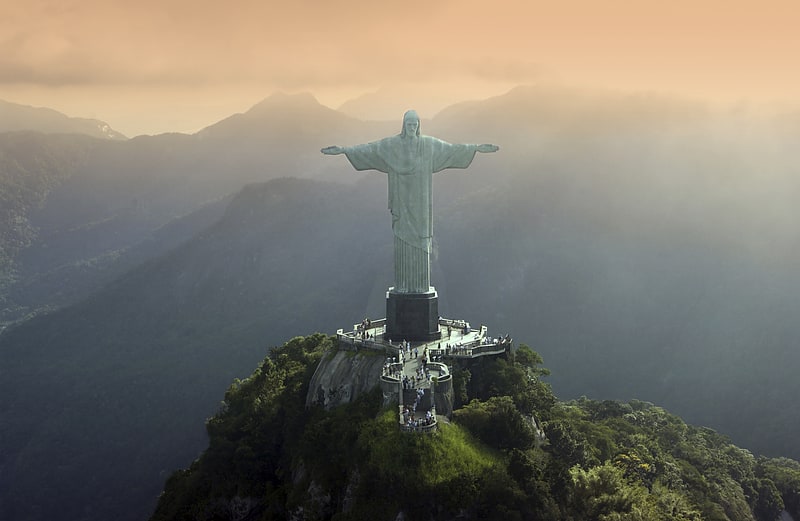
Also known as: Cristo Redentor
Iconic Christ statue atop a mountain. Christ the Redeemer is an Art Deco statue of Jesus Christ in Rio de Janeiro, Brazil, created by French sculptor Paul Landowski and built by Brazilian engineer Heitor da Silva Costa, in collaboration with French engineer Albert Caquot. Romanian sculptor Gheorghe Leonida fashioned the face. Constructed between 1922 and 1931, the statue is 30 metres high, excluding its 8-metre pedestal. The arms stretch 28 metres wide. It is made of reinforced concrete and soapstone.
The statue weighs 635 metric tons (625 long, 700 short tons), and is located at the peak of the 700-metre (2,300 ft) Corcovado mountain in the Tijuca National Park overlooking the city of Rio de Janeiro. A symbol of Christianity around the world, the statue has also become a cultural icon of both Rio de Janeiro and Brazil and was voted one of the New Seven Wonders of the World.[1]
Address: Estr. do Corcovado, s/n, 20531-540 Rio de Janeiro
Sugarloaf Mountain
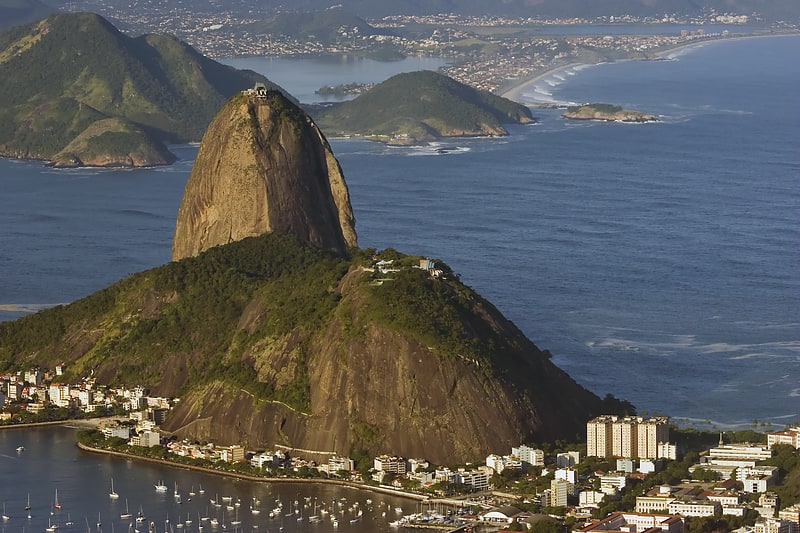
Also known as: Pão de Açúcar
Peak with a cableway and panoramic views. Sugarloaf Mountain is a peak situated in Rio de Janeiro, Brazil, at the mouth of Guanabara Bay on a peninsula that juts out into the Atlantic Ocean. Rising 396 m above the harbor, its name is said to refer to its resemblance to the traditional shape of concentrated refined loaf sugar. It is known worldwide for its cableway and panoramic views of the city and beyond.
The mountain is one of several monolithic granite and quartz mountains that rise straight from the water's edge around Rio de Janeiro. Geologically, it is considered part of a family of steep-sided rock outcroppings known as non-inselberg bornhardts.
The mountain is protected by the Sugarloaf Mountain and Urca Hill Natural Monument, created in 2006. This became part of a World Heritage Site declared by UNESCO in 2012.[2]
Address: Av. Pasteur, 520, 22290-255 Rio de Janeiro (Botafogo)
MAM
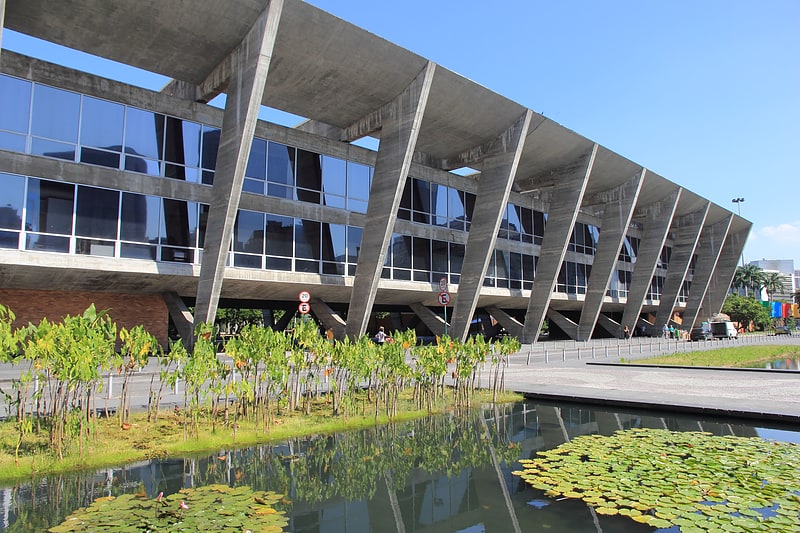
Also known as: Museu de Arte Moderna do Rio de Janeiro
Modern art museum with unique gardens. The Museum of Modern Art in Rio de Janeiro is a museum located in northeastern Flamengo Park, in the city of Rio de Janeiro, Brazil. It is in the Centro district, west of Santos Dumont Airport, on Guanabara Bay.[3]
Address: Av. Infante Dom Henrique, 85, 20021-140 Rio de Janeiro (Botafogo)
Eva Klabin House Museum
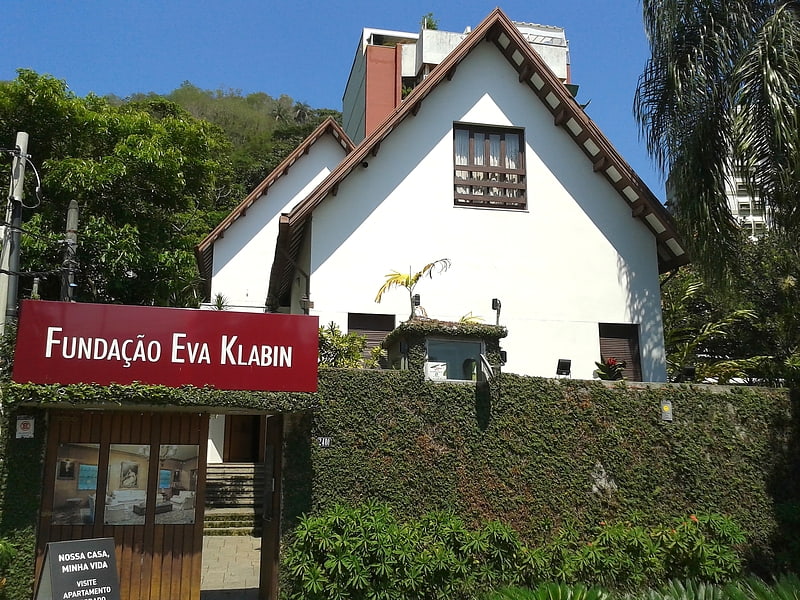
Museum. The Eva Klabin House Museum is an historic house museum located in the city of Rio de Janeiro, Brazil. It is a private institution established in 1990 by the Brazilian collector and philanthropist Eva Klabin, with the purpose of preserving and displaying the art collection gathered together during her life. The collection is open to the public in the house where Klabin lived for over thirty years. It is considered one of the largest classical art collections in Brazilian museums, with over 2000 works spanning almost 5000 years, from Ancient Egypt to Impressionism.[4]
Address: Avenida Epitacio Pessoa 2480, 22471-003 Rio de Janeiro (Lagoa)
Paço Imperial
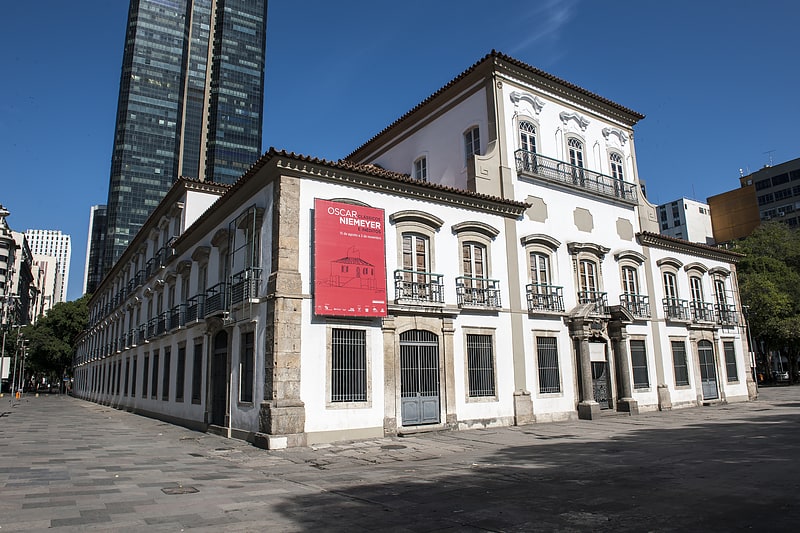
Culture and arts center in a former palace. The Paço Imperial, or Imperial Palace, previously known as the Royal Palace of Rio de Janeiro and Palace of the Viceroys, is a historic building in the center of the city of Rio de Janeiro, Brazil. The Paço Imperial was built in the 18th century to serve as a residence for the governors of colonial Brazil. From 1808, it was used as a royal residence by King John VI of Portugal as King of Portugal and later also as King of Brazil. In 1822 it became the city palace of the monarchs of the Empire of Brazil, Pedro I and Pedro II, who used it not as a residence, but as a workplace. It was one of the main political centers of Brazil for nearly 150 years, from 1743 to 1889.
The Paço Imperial is located in the Praça XV de Novembro in central Rio. Due to its architectural and historical significance, it is one of Brazil's most important historic buildings. Today it serves as a cultural center.[5]
Address: Praça Quinze de Novembro, 48, 20010-000 Rio de Janeiro
Paço de São Cristóvão
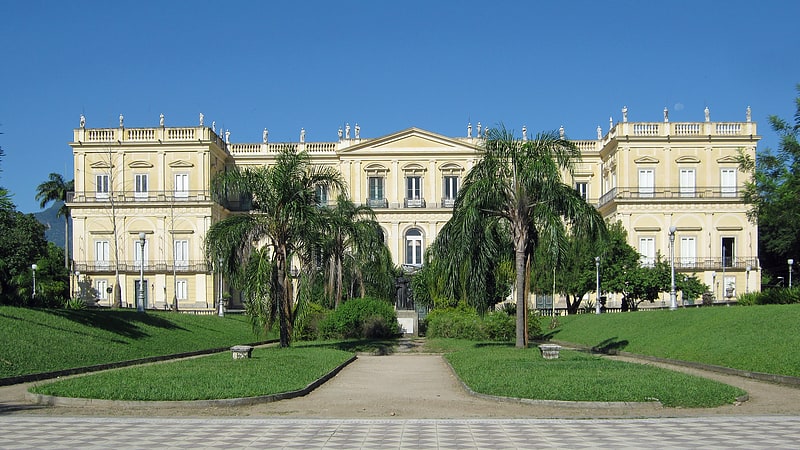
Palace in Brazil. Paço de São Cristóvão was an imperial palace located in the Quinta da Boa Vista park in the Imperial Neighbourhood of São Cristóvão, Rio de Janeiro, Brazil. It served as residence to the Portuguese Royal Family and later to the Brazilian Imperial Family until 1889, when the country became a republic through a coup d'état deposing Emperor Pedro II. The palace briefly served as a public building by the provisional government for the constituent assembly of the first republican constitution. It housed the major part of the collections of the National Museum of Brazil, which, together with the building, were largely destroyed by a fire on 2 September 2018.[6]
Address: Rio de Janeiro, Quinta da Boa Vista
Pedra da Gávea
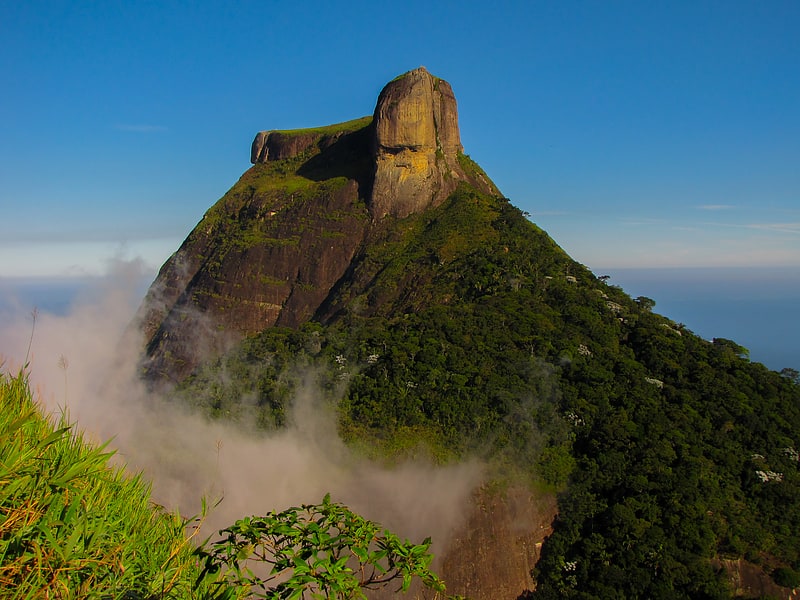
High-elevation mountain on the ocean. Pedra da Gávea is a monolithic mountain in Tijuca Forest, Rio de Janeiro, Brazil. Composed of granite and gneiss, its elevation is 844 metres, making it one of the highest mountains in the world that ends directly in the ocean. Trails on the mountain were opened up by the local farming population in the early 1800s; today, the site is under the administration of the Tijuca National Park.
The mountain's name translates as Rock of the Topsail, and was given to it during the expedition of Captain Gaspar de Lemos, begun in 1501, and in which the Rio de Janeiro bay (today Guanabara Bay, but after which the city was named) also received its name. The mountain, one of the first in Brazil to be named in Portuguese, was named by the expedition's sailors, who compared its silhouette to that of the shape of a topsail of a carrack upon sighting it on January 1, 1502. That name in turn came to be given to the Gávea area of the city of Rio de Janeiro.
Differential weathering on one side of the rock has created what is described as a stylized human face. Markings on another face of the rock have been described as an inscription. Geologists and scientists are nearly in agreement that the "inscription" is the result of erosion and that the "face" is a product of pareidolia. Furthermore, the consensus of archaeologists and scholars in Brazil is that the mountain should not be viewed as an archaeological site.[7]
Address: Estr. Sorimã, Rio de Janeiro (Lagoa)
Candelária Church
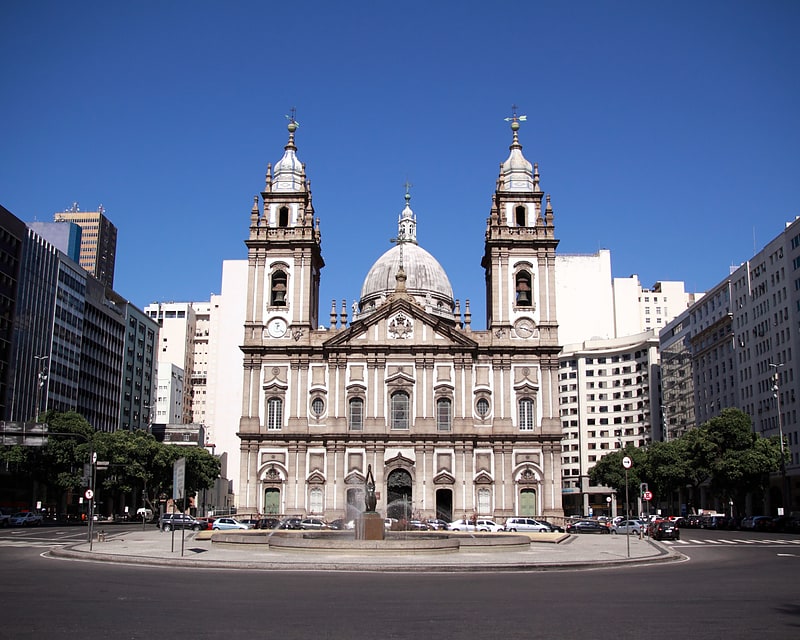
Also known as: Igreja de Nossa Senhora da Candelária
Catholic church with a baroque facade. The Candelária Church is an important historical Roman Catholic church in the city of Rio de Janeiro, in southeastern Brazil. It was built and decorated during a long period, from 1775 to the late 19th century. The church combines a Portuguese colonial Baroque façade with later Neoclassical and Neo-Renaissance interior elements.[8]
Address: Praça Pio X, s/n, 20040-020 Rio de Janeiro
Palácio Laranjeiras

The Palácio Laranjeiras is the official residence of the governor of the State of the Rio de Janeiro, Brazil.
The palace is located within Eduardo Guinle Park, a park in the Laranjeiras neighbourhood of the city of Rio de Janeiro.
Formerly the residence of one of the wealthiest Brazilian families, the palace was purchased by the Brazilian Federal Government in 1947 to host visitors, such as foreign Heads of State or Heads of Government. At that time, the city of Rio de Janeiro was the capital of Brazil. In 1974, the Federal Government ceded ownership of the palace to the former State of Guanabara.
Before becoming the official residence of the State Governor, the Palace was a Presidential Residence. Its use as an official residence began in the Presidency of Jucelino Kubitschek, who opted to use the seat of the presidency, Catete Palace, solely as a workplace. President Kubitschek used Laranjeiras Palace as his main residence until the transfer of the Federal capital to Brasília.
From the transfer of the seat of the Government to the new capital city of Brasília in 1960 until 1974, when it was ceded to the Rio de Janeiro State Government, Laranjeiras Palace remained an official palace of the Presidency of the Republic, for use as a residence and workplace of the Nation's chief executive when the President was in Rio de Janeiro. During the first decade after the founding of Brasília it was very common for presidents to travel to Rio de Janeiro and to spend a considerable amount of time in there, as although no longer the capital, in the 1960s Rio de Janeiro was still home to all foreign embassies. Brasília was not regarded as a good place to live, as many services had not yet been established in the new capital, so during the sixties, several important official acts of Government took place in Laranjeiras Palace. In the 70's, use of the Palace by the presidency declined as the city of Brasília grew, leading to the decision by the Federal Government to hand over the palace to the State Government of Rio de Janeiro.[9]
Address: Parque Eduardo Guinle, Rio de Janeiro (Botafogo)
Museu Histórico Nacional
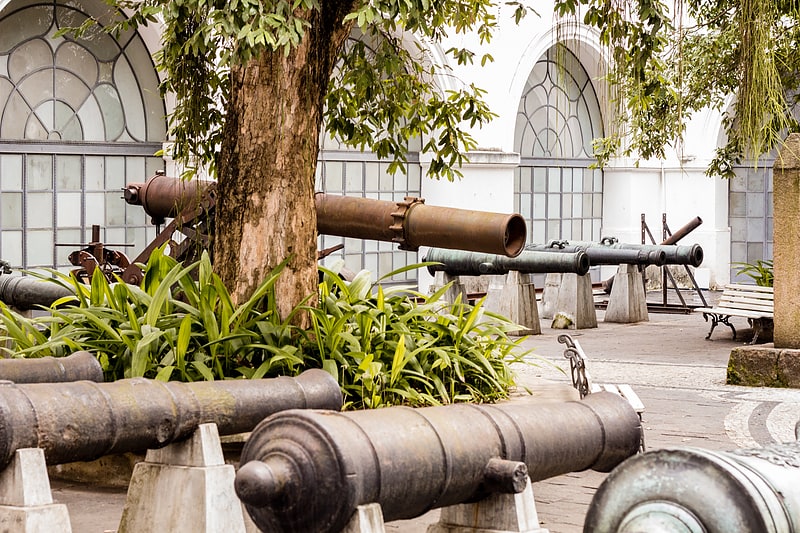
Museum with national history exhibits. The National Historical Museum of Brazil was created in 1922, and possesses over 287,000 items, including the largest numismatic collection of Latin America. The architectural complex that houses the museum was built in 1603 as the St. James of Mercy Fort; earlier structures date back to 1567, erected by order of King Sebastian I of Portugal. In 1693, the Calaboose Prison, for slaves, was built. In 1762, the Casa do Trem was added as a depot of weapons and ammunition. The last additions are the War Arsenal and the Barracks.[10]
Address: Praça Mal. Âncora, s/n, 20021-200 Rio de Janeiro
Rio de Janeiro Cathedral
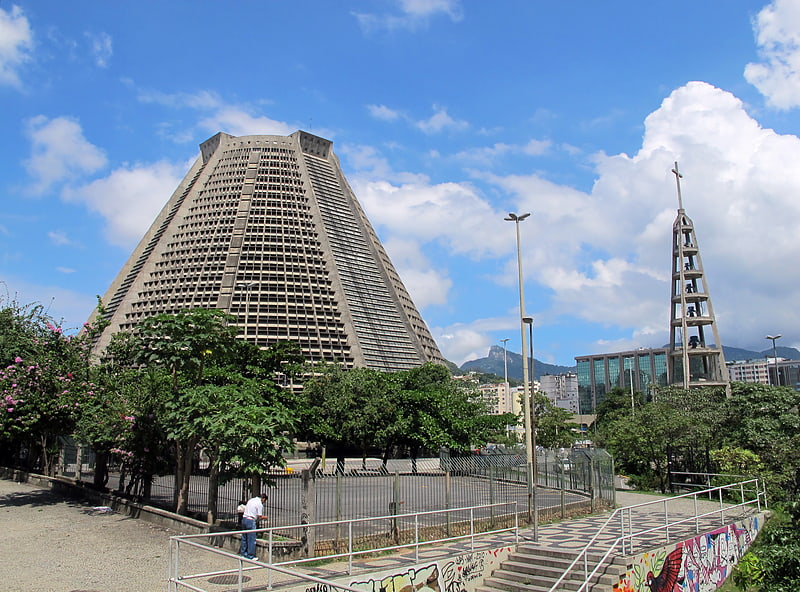
Also known as: Catedral de São Sebastião do Rio de Janeiro
Modern pyramid-shaped Catholic cathedral. The Metropolitan Cathedral of Saint Sebastian, better known as the Metropolitan Cathedral of Rio de Janeiro or as the Cathedral of St. Sebastian of Rio de Janeiro, is the seat of the Roman Catholic Archdiocese of São Sebastião do Rio de Janeiro. The cathedral is the See of the Metropolitan Archbishops of the city of Rio de Janeiro, Brazil. The church is dedicated to Saint Sebastian, the patron saint of Rio de Janeiro.[11]
Address: Av. Rep. do Chile, 245, 20031-170 Rio de Janeiro
Aterro do Flamengo
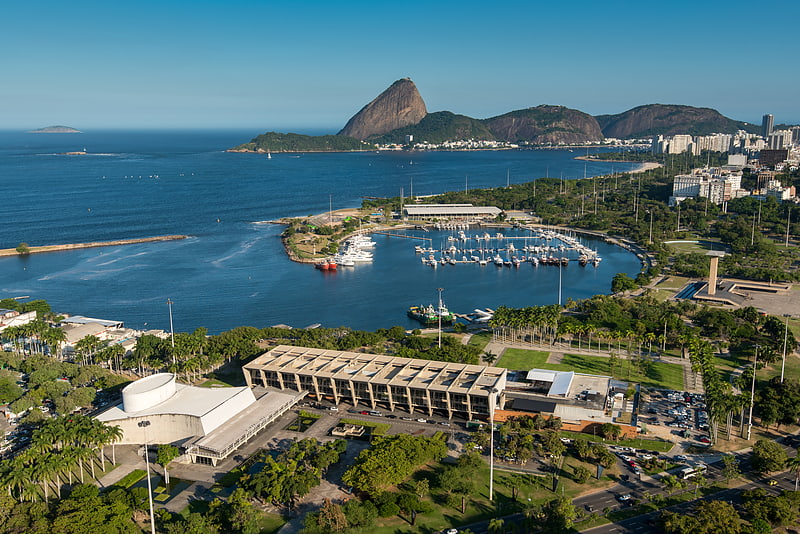
Park in Rio de Janeiro, Brazil. Flamengo Park, also known as Aterro do Flamengo, Eduardo Gomes Park, and Aterro do Brigadeiro Eduardo Gomes, is the largest public park and recreation area within the city of Rio de Janeiro, in eastern Brazil.
The park is located along Guanabara Bay, in the Flamengo district of the city, between Downtown Rio and Copacabana.[12]
Address: Aterro do Flamengo - Baía de Guanabara, Rio de Janeiro (Botafogo)
Earth Sciences Museum
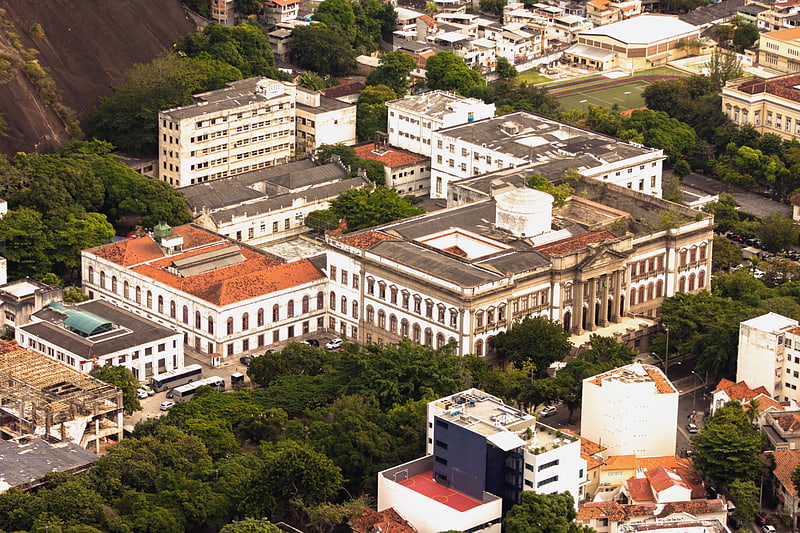
Museum in Rio de Janeiro, Brazil. The Earth Sciences Museum is a geological museum in Rio de Janeiro, Brazil. The building was part of the National Exposition of Brazil in 1908. Its collection includes minerals, fossils, and geological exhibits. The building was constructed in 1907 for the National Exposition of Brazil and was intended to be permanent. At the exposition it was the States Pavilion.[13]
Address: Avenida Pasteur 404, 22290-255 Rio de Janeiro (Botafogo)
Morro da Urca
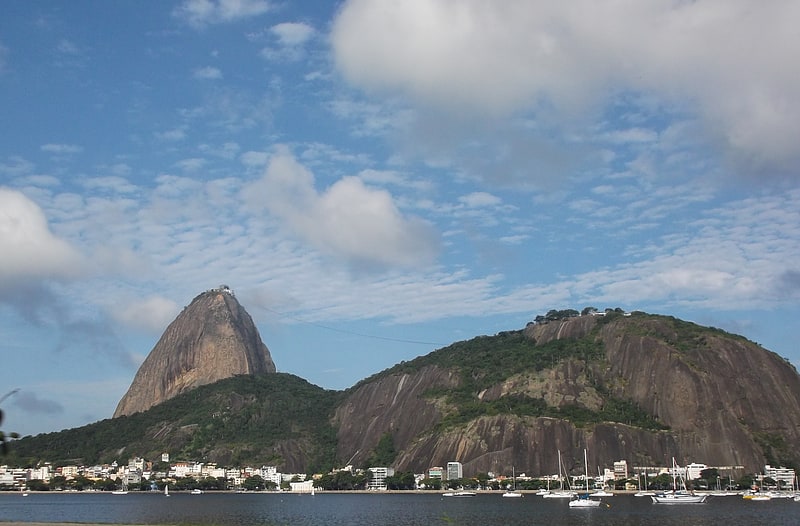
The Sugarloaf Mountain and Urca Hill Natural Monument is a natural monument in the city of Rio de Janeiro, Brazil. It protects the Sugarloaf Mountain and the adjoining Morro da Urca, distinctive landmarks of the city.[14]
Address: Morro da Urca, Rio de Janeiro (Botafogo)
Quinta da Boa Vista
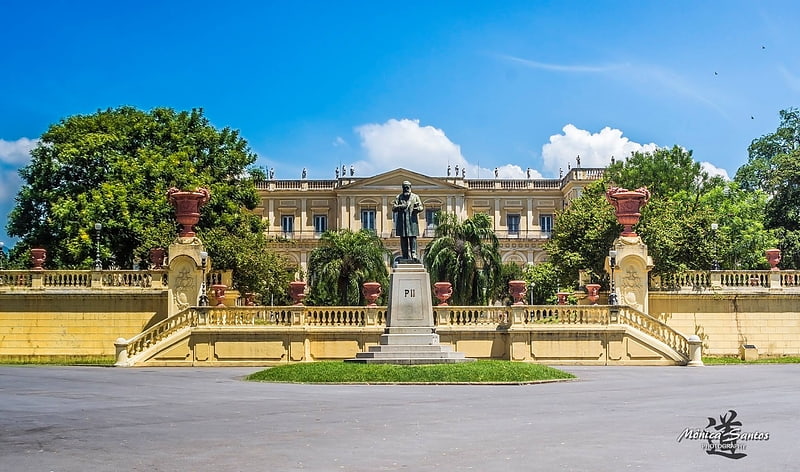
Public park with historic buildings. The Quinta da Boa Vista is a public park of great historical importance located in the São Cristóvão neighbourhood, in the North zone of the city of Rio de Janeiro, Brazil. The park was part of the gardens of the São Cristóvão Palace, the residence of the Emperors of Brazil in the 19th century and the home of the Zoological Garden of Rio de Janeiro, with over 2000 species of animals. The building of the old palace hosted the National Museum, with collections on natural history, ethnology and archaeology.[15]
Address: 250 Avenida Pedro II, Rio de Janeiro (São Cristóvão)
Tijuca National Park
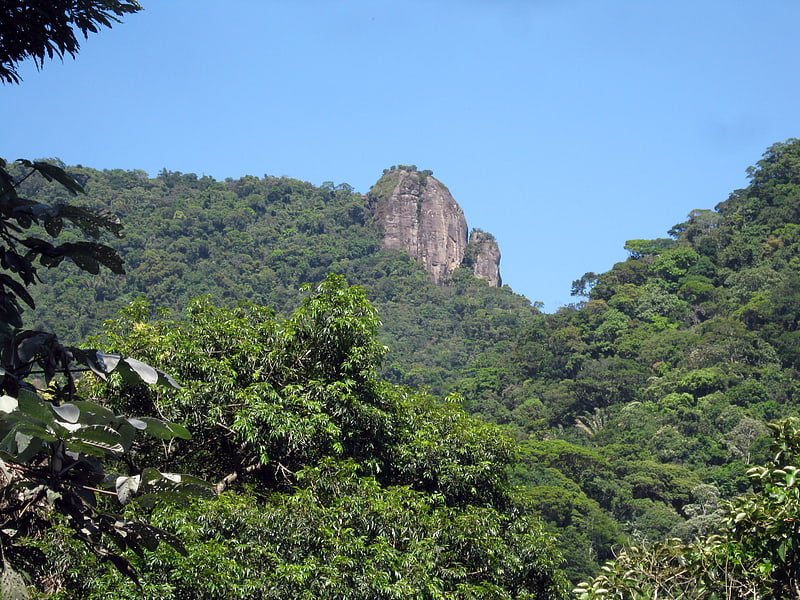
Also known as: Floresta da Tijuca
Rio's rainforest, with famed views. The Tijuca National Park is an urban national park in the mountains of the city of Rio de Janeiro, Brazil. The park is part of the Atlantic Forest Biosphere Preserve, and is administered by the Chico Mendes Institute for Biodiversity Conservation.[16]
Carmen Miranda Museum
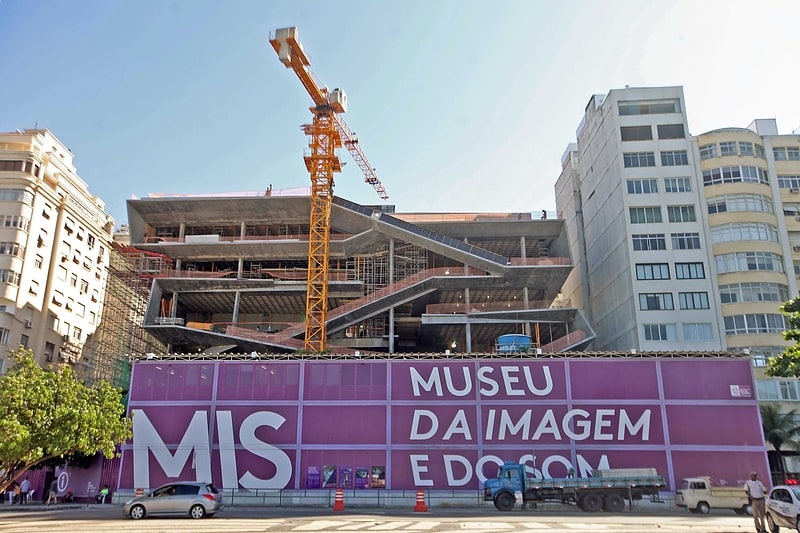
Also known as: Museu Carmen Miranda
Museum in Rio de Janeiro, Brazil. Carmen Miranda Museum, located in the Parque Brigadeiro Eduardo Gomes, is a museum established in homage to singer and actress Carmen Miranda and open to the public since 1976. The museum was officially opened on the 21st anniversary of her death.
The museum exhibits iconographic costumes, including her tall fruit hats and platform-heeled shoes, and artifacts belonging to Carmen, as well as many of her records and films. In the second half of 2015, the new headquarters for the Carmen Miranda Museum will be opened at Rio de Janeiro's new Museum of Image and Sound (MIS).[17]
Address: Av. Rui Barbosa, 22250 Rio de Janeiro (Botafogo)
Museu Nacional de Belas Artes
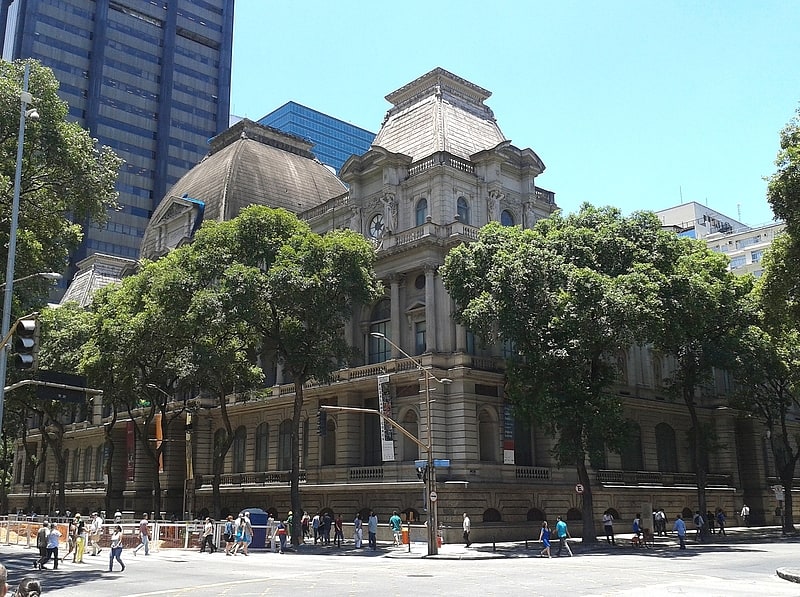
Large art collection and sculpture gallery. The Museu Nacional de Belas Artes is a national art museum located in the city of Rio de Janeiro, Brazil. The museum, officially established in 1937 by the initiative of education minister Gustavo Capanema, was inaugurated in 1938 by President Getúlio Vargas. The museum collection, on the other hand, takes its rise in the transfer of the Portuguese Court to Brazil in the early 19th century, when King John VI brought along with him part of the Portuguese Royal Collection. This art collection stayed in Brazil after the King's return to Europe and became the core collection of the National School of Fine Arts. When the museum was created in 1937, it became the heir not only the National School collection, but also of its headquarters, a 1908 eclectic style building projected by Spanish architect Adolfo Morales de los Ríos.
The Museu Nacional de Belas Artes is one of the most important cultural institutions of the country, as well as the most important museum of Brazilian art, particularly rich in 19th-century paintings and sculptures. The collection includes more than 20,000 pieces, among paintings, sculptures, drawings and prints, of Brazilian and international artists, ranging from High Middle Ages to contemporary art. It also includes smaller assemblages of decorative arts, folk and African art. The museum library has a collection of about 19,000 titles. The building was listed as Brazilian national heritage in 1973.[18]
Address: Avenida Rio Branco 199, 20040-008 Rio de Janeiro
Theatro Municipal

Ornate theater with tours and performances. The Theatro Municipal is an opera house in the Centro district of Rio de Janeiro, Brazil. Built in the early twentieth century, it is considered to be one of the most beautiful and important theaters in the country.
The building is designed in an eclectic style, inspired by the Paris Opéra of Charles Garnier. The outside walls are inscribed with the names of classic European & Brazilian artists. It is located near the National Library and the National Fine Arts Museum, overlooking the spacious Cinelândia square.[19]
Address: Praca Floriano, 20031-050 Rio de Janeiro
Arcos da Lapa
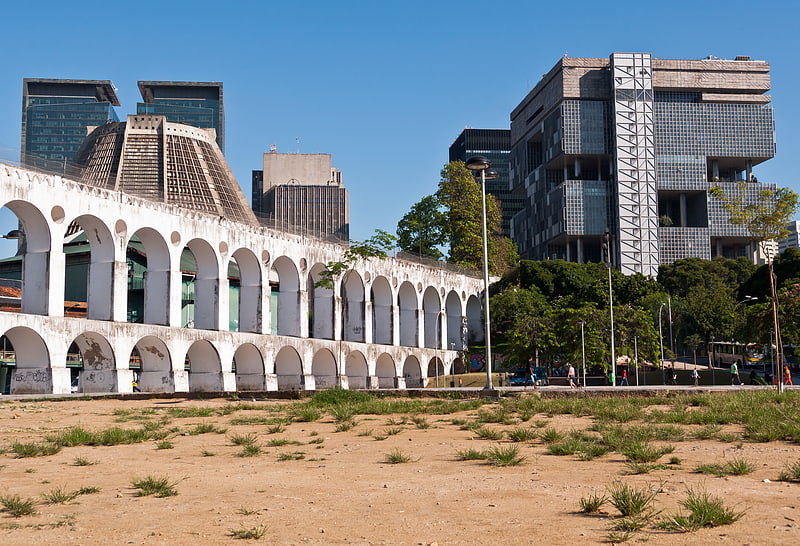
Also known as: Aqueduto da Carioca
Elegant, 18th-century aqueduct. The Carioca Aqueduct is an aqueduct in the city of Rio de Janeiro, Brazil. The aqueduct was built in the middle of the 18th century to bring fresh water from the Carioca River to the population of the city. It is a typical example of colonial architecture and engineering.
The Carioca Aqueduct is located in the centre of the city, in the Lapa neighbourhood, and is frequently called Arcos da Lapa by Brazilian people. Since the end of the 19th century the aqueduct serves as a bridge for a popular tram that connects the city centre with the Santa Teresa neighbourhood uphill, the Santa Teresa Tramway.[20]
Address: Rua Riachuelo 27, 20230-010 Rio de Janeiro
Três soldados

Also known as: Monumento aos Mortos da Segunda Guerra Mundial
Commemorative 1960 WWII monument. The Monument to the Dead of World War II, also the Monument to the Brazilian Soldiers of World War II, commemorates Brazil's participation and losses in the Second World War.
It is located in Flamengo Park (also known as Aterro do Flamengo and Parque Eduardo Gomes) on Guanabara Bay, in the Flamengo neighborhood of Rio de Janeiro, Brazil.[21]
Address: Avenida Infante Dom Henrique Nr 75, 20021-140 Rio de Janeiro (Botafogo)
Corcovado

Landmark mountain with panoramic views. Corcovado, which means "hunchback" in Portuguese, is a mountain in central Rio de Janeiro, Brazil. It is a 710-metre granite peak located in the Tijuca Forest, a national park.
Corcovado hill lies just west of the city center but is wholly within the city limits and visible from great distances. It is known worldwide for the 38-metre (125 ft) statue of Jesus atop its peak, entitled Christ the Redeemer, which was voted as one of the New Seven Wonders of the World.[22]
Museu da Imagem e do Som do Rio de Janeiro
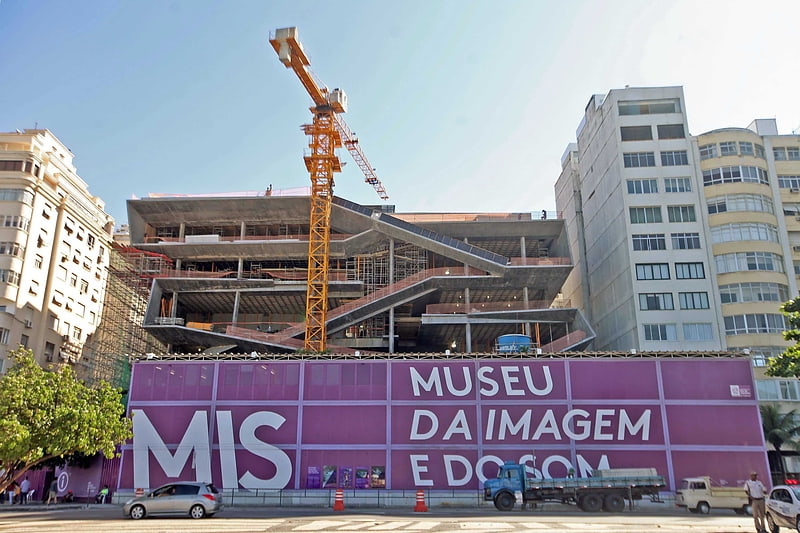
The Museu da Imagem e do Som do Rio de Janeiro was inaugurated on September 3, 1965, as part of celebrations of the fourth centenary of the city of Rio de Janeiro. The MIS is a museum of the Secretary of Culture of the state of Rio de Janeiro dedicated to carioca culture.
The institution has launched a pioneering gender audiovisual museum, which would be followed in other Brazilian cities. In addition to having qualified as music and picture documentation center, it was also a cultural center of avant-garde in the 1960s and 1970s, a place of meetings and launching new ideas and behaviors. Currently, the MIS has its administrative headquarters in Lapa and a unit at Praça XV in the same region.
The building of the new headquarters of MIS, in Copacabana was announced in 2009, in the place of the old nightclub Help, an old point of prostitution in the city. The building will also house the Carmen Miranda Museum collection, now located in the Flamengo Park. The inauguration is scheduled for 2018.[23]
Address: Av. Europa 158, Rio de Janeiro (Botafogo)
Igreja e Mosteiro de São Bento
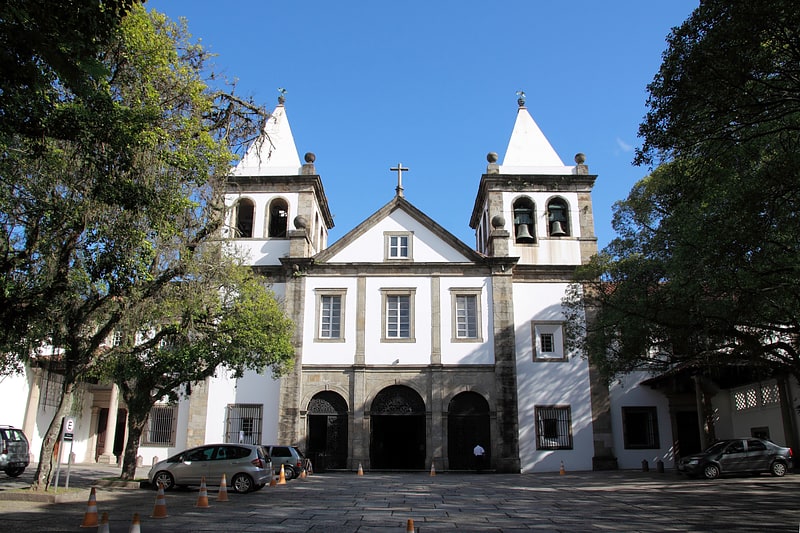
Also known as: Mosteiro de São Bento
Convent in Rio de Janeiro, Brazil. The Abbey of Our Lady of Montserrat, more commonly known as the Mosteiro de São Bento, is a Benedictine abbey located on the Morro de São Bento in downtown Rio de Janeiro, Brazil. The Mannerist style church is a primary example of Portuguese colonial architecture in Rio and the country.
The abbey was founded by Benedictine monks who came from the state of Bahia in 1590. It is still operational today, along with the Colégio de São Bento (St. Benedict College) nearby. The college, established in 1858, is one of the most important traditional educational establishments in Brazil and claims many famous alumni. The abbey includes the Faculdade de São Bento (St. Benedict Seminary), with courses in theology and philosophy that are recognized by the Ministry of Education. Theological studies at the monastery are also affiliated with the Pontifical Atheneum of St. Anselm in Rome.[24]
Address: R. D. Gerardo, 68, 20090-030 Rio de Janeiro
Praça da Apoteose

The Apotheosis Square is a venue in Rio de Janeiro close to the Morro da Mineira favela. It is part of Sambadrome Marquês de Sapucaí, which can hold a maximum 90,000 people. For concerts, it can hold from 10,000 to 40,000 people.
It was designed by well-known architect Oscar Niemeyer in 1983.
In 1989, the band A-ha played 2 concerts with an attendance of 80.000 people each.
On July 7, 2007 (07/07/07) the band Diante do Trono recorded their 10th album, called Príncipe da Paz (Prince of Peace). In the event, more than 100,000 people were gathered, packing the venue.
On March 14, 2010, a stage collapsed before a Guns N' Roses concert due to heavy rain and a small tornado. The concert was rescheduled to April 4.[25]
Solar do Marques do Lavradio
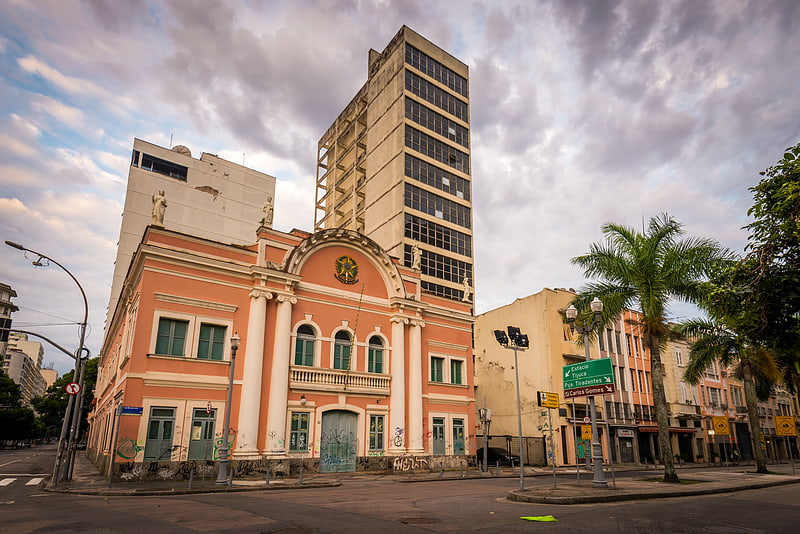
Solar do Marquês do Lavradio is an 18th-century palace located in Rio de Janeiro, Central Zone, Lapa, Rua do Lavradio, nº 84.
In 1967 the historic building was assigned to the Sociedade Brasileira de Belas Artes SBBA (Brazilian Society of Fine Arts).[26]
Address: 97 Rua do Lavradio, Rio de Janeiro
Parque Lage

Park in Rio de Janeiro, Brazil. Parque Enrique Lage is a public park in the city of Rio de Janeiro, located in the Jardim Botânico neighborhood at the foot of the Corcovado, on top of which Christ the Redeemer is located.
The land was formerly the residence of industrialist Henrique Lage and his wife, singer Gabriella Besanzoni. During the 1920s Lage had the mansion remodeled by Italian architect Mario Vodret, with interior paintings by Salvador Payols Sabaté.
The National Historical and Artistic Heritage Institute (IPHAN) listed Parque Lage, on June 14 1957, as a historical and cultural heritage site for the city of Rio de Janeiro.
In the 1960s the land became a public park, with walking trails through subtropical forest. The Escola de Artes Visuais do Parque Lage (Visual Arts School of Parque Lage) and a café open to the public operate from the former mansion.
The mansion was used as the British Olympic Team hospitality house and is notably featured in the 2003 music video for Snoop Dogg's single "Beautiful".[27]
Address: Rua Jardim Botanico 414, 22461-000 Rio de Janeiro (Lagoa)
Old Cathedral of Rio de Janeiro
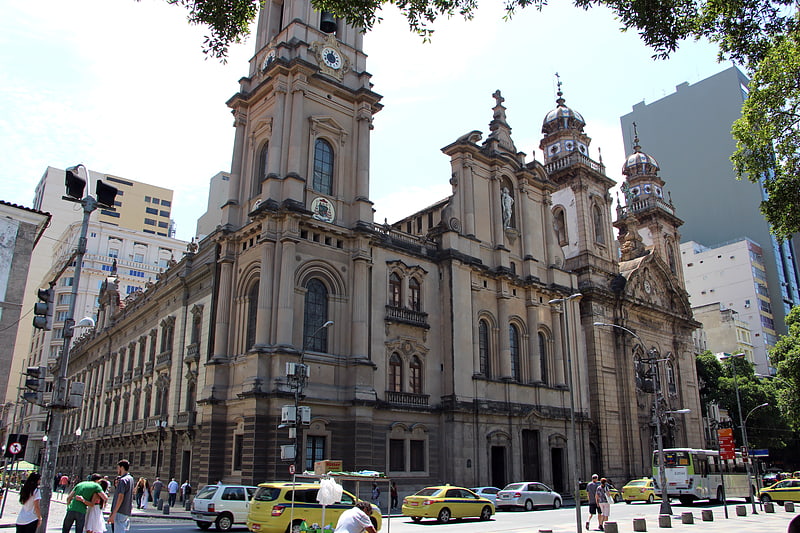
Also known as: Igreja de Nossa Senhora do Monte do Carmo
Building. The Old Cathedral of Rio de Janeiro dedicated to Our Lady of Mount Carmel, is an old Carmelite church which served as cathedral of Rio de Janeiro from around 1808 until 1976. During the 19th century, it was also used successively as Royal and Imperial Chapel by the Portuguese Royal Family and the Brazilian Imperial Family, respectively. It is located in the Praça XV square, in downtown Rio. It is one of the most important historical buildings in the city.[28]
Address: R. Primeiro de Março, S/N, 20080-002 Rio de Janeiro
Fort Copacabana

Also known as: Forte de Copacabana
Distance events beside a historic fort. Fort Copacabana is a military base at the south end of the beach that defines the district of Copacabana, Rio de Janeiro. The base is open to the public and contains the Museu Histórico do Exército and a coastal defense fort that is the actual Fort Copacabana.[29]
Address: Praça Coronel Eugênio Franco, Rio de Janeiro (Lagoa)
Estádio Olímpico Nilton Santos

Multi-purpose stadium in Rio de Janeiro, Brazil. Estádio Olímpico Nilton Santos is a multi-purpose stadium located in the neighbourhood of Engenho de Dentro in Rio de Janeiro, Brazil. It is used mostly for football matches and athletics and is the home stadium of the football club Botafogo. The stadium was built by a consortium under the leadership of Odebrecht S.A. from 2003 through to 2007, opening in time for the 2007 Pan American Games. It hosted the athletics competitions at the 2016 Summer Olympics and the 2016 Summer Paralympics. It was one of the five venues for the 2021 Copa América.
The stadium is known by a number of names. The nickname Engenhão refers to the location of the stadium. The stadium was named after former FIFA president and International Olympic Committee (IOC) member João Havelange. Havelange died after an attack of pneumonia during the 2016 Olympics at age 100. Between 2015 and 2017 the Rio municipality allowed Botafogo to refer to the stadium as Estádio Nilton Santos (English: Nilton Santos Stadium). The name honors Nílton Santos, regarded as one of the greatest defenders in the history of the game and a member of the World Team of the 20th Century. Botafogo made initial efforts to have the name change official but this was not immediately successful. In February 2017, the city of Rio de Janeiro officially renamed the stadium Estádio Olímpico Nilton Santos. Structural problems in the roof were identified in March 2013 that caused the stadium to be closed for repair. The stadium's capacity was increased to 60,000 for the Games.[30]
Address: Rua Jose dos Reis 425, 20756-115 Rio de Janeiro (Méier)
Copacabana Beach
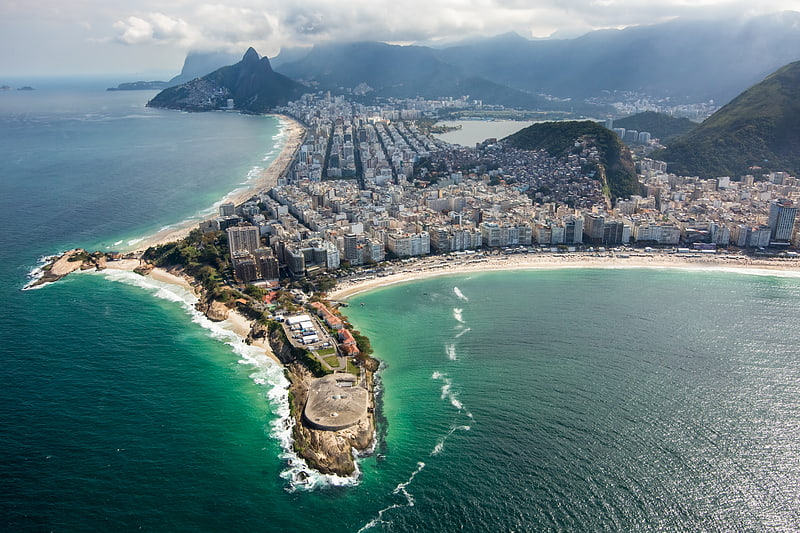
Also known as: Copacabana
Copacabana is a bairro located in the South Zone of the city of Rio de Janeiro, Brazil. It is most prominently known for its 4 km balneario beach, which is one of the most famous in the world.[31]
Address: Av. Atlântica, Rio de Janeiro
Lapa
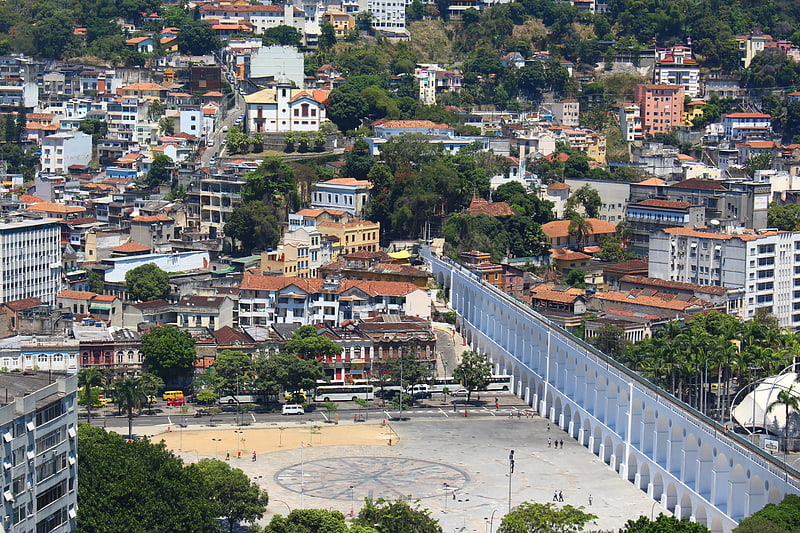
Neighborhood in Rio de Janeiro, Brazil. Lapa is a neighborhood in the city of Rio de Janeiro, in Brazil. It is located in the centre of Rio and is famous for its historical monuments and nightlife.
The neighborhood is home to the Arcos da Lapa, an impressive aqueduct constructed in the mid-18th century by colonial authorities. Another important historical attraction is the Passeio Público, the first public park of the city, built in the 1780s.
Since the early 1950s, Lapa has been known for its lively cultural life where there is a concentration of many restaurants and bars where Brazilian artists and intellectuals would meet. It was, and still is, famous for its many restaurants, bars and clubs where the various forms of Brazilian music can be appreciated, like the Asa Branca bar and the Fundição Progresso. The Sala Cecília Meireles, an important venue for chamber music, is also located in Lapa.[32]
Estádio São Januário
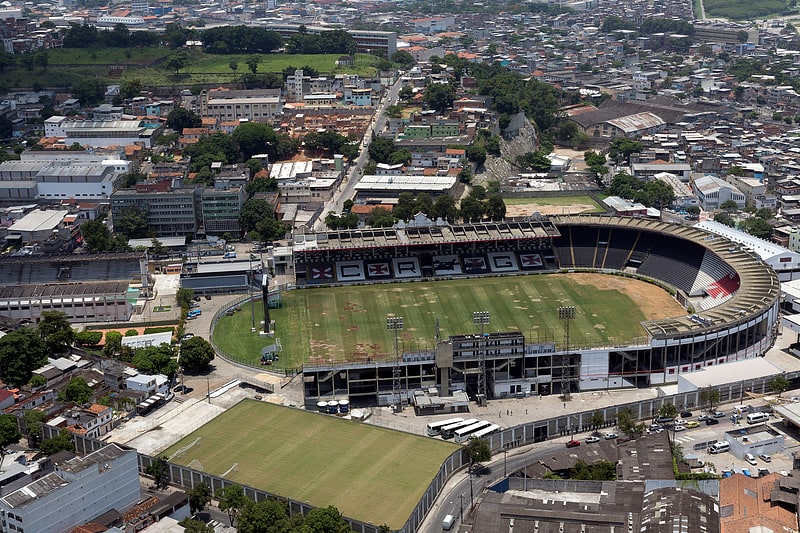
Also known as: Estádio Vasco da Gama
Stadium in Rio de Janeiro, Brazil. Estádio Vasco da Gama, also known as Estádio São Januário, owing to its location on a street of the same name, is the home ground of Club de Regatas Vasco da Gama. Its facade is listed by the National Historical and Artistic Heritage.
It is located in the Vasco da Gama neighborhood, Rio de Janeiro, Brazil, on a hill near the National Observatory of Brazil. Because of its position it is often referred to as Estádio da Colina (Hill's Stadium) which in turn has given Vasco the nickname of Gigante da Colina (Hill's Giant). It is one of the few Association Football specific stadiums in the world which has both team benches and coaching areas behind the goal line at the same end of the field.
The stadium had a capacity of 24,584 and it was inaugurated on April 21, 1927, with the presence of Washington Luís, Brazilian president in that time. The first event held in the stadium was a match between Vasco and Santos, which Santos won. The stadium stands as the biggest private venue in the State of Rio de Janeiro.
This stadium has also historic importance, because Brazilian president Getúlio Vargas used it many times to do deliver speeches to the Brazilian people. Vargas announced the first Brazilian work laws on the tribune of São Januário.
Vasco da Gama, owner of São Januário, is the only major football club in Rio de Janeiro to have its private stadium. Other major clubs (Flamengo, Fluminense, and Botafogo) rent their stadiums (Flamengo and Fluminense play at Maracanã which is owned by the state of Rio de Janeiro, while Botafogo plays at Estádio Nilton Santos which is owned by the city of Rio de Janeiro).[33]
Address: R. Gen. Almério de Moura, 131, 20921-060 Rio de Janeiro (São Cristóvão)
Campo de Santana Park
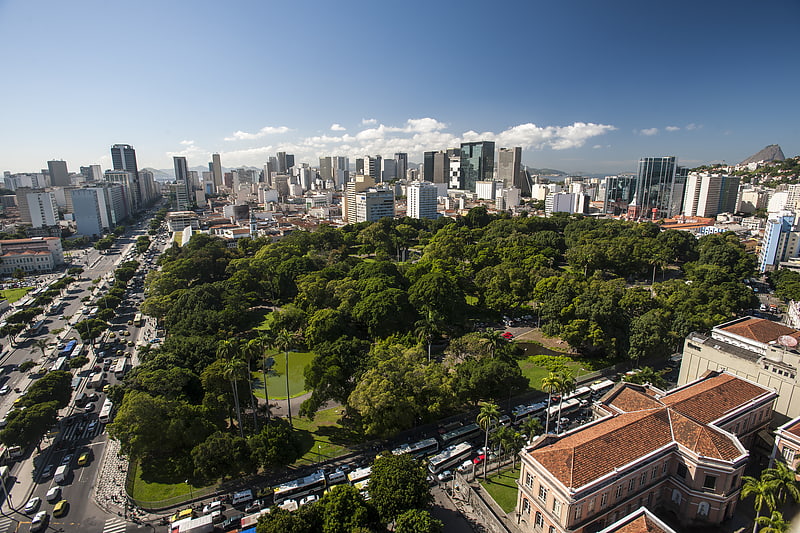
Also known as: Campo de Santana
Park in Rio de Janeiro, Brazil. The Campo de Santana is a park located in the Praça da República in downtown Rio de Janeiro, Brazil. The name of the plaza refers to the fact that it is located near the site where the Brazil was declared a Republic in 1889.[34]
Address: Campo de Santana, Rio de Janeiro
Rio Sul
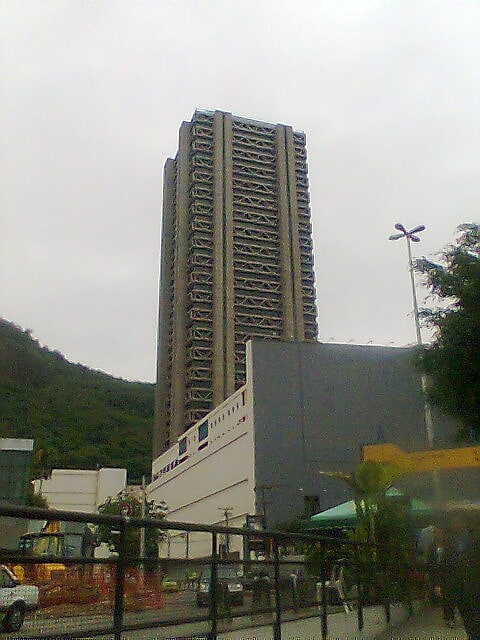
Building in Rio de Janeiro, Brazil. The Rio Sul Center Tower, also known as Rio Sul Tower, is the fourteenth tallest building in Brazil and the tallest building in Rio de Janeiro at 164 metres and 50 floors, 48 above ground and 2 below. The structure contains 28 elevators It was completed in 1982.
The building was designed by architects Ulysses Burlamaqui and Alexandre Chan in the Brutalist architectural style. The tower, together with a 400 stores shopping mall called Riosul Shopping Center, form a commercial complex known as Rio Sul Center.[35]
Address: Rua Lauro Muller 116, 22290-906 Rio de Janeiro (Botafogo)